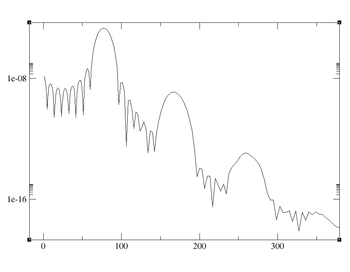Above-threshold ionization
In atomic, molecular, and optical physics, above-threshold ionization (ATI), is a multi-photon effect where an atom is ionized with more than the energetically required number of photons.[1] It was first observed in 1979.[2]

Photoelectrons
In the case of ATI the photoelectron peaks should appear at
where the integer n represents the minimal number of photons absorbed, and the integer s represents the number of additional photons absorbed. W is the ionization energy, and is the electron kinetic energy of the peak corresponding to s additional photons being absorbed.[3]
Structure
It typically has a strong maximum at the minimal number of photons to ionize the system, with successive peaks (known as ATI peaks) separated by the photon energy and thus corresponding to higher numbers of photons being absorbed.[1][4]
In the non-perturbative regime the bound states are dressed with the electric field, shifting the ionization energy. If the ponderomotive energy of the field is greater than the photon energy , then the first peak disappears.[3]
Features from ultrashort pulses
High intensity ultrashort pulse lasers can create ATI features with 20 or more peaks.[5] The photoelectron spectrum of electron energies is continuous since actual light sources contain a spread of energies.
References
- Parker, Jonathan; Clark, Charles W. (1 February 1996). "Study of a plane-wave final-state theory of above-threshold ionization and harmonic generation". Journal of the Optical Society of America B. 13 (2): 371. Bibcode:1996JOSAB..13..371P. doi:10.1364/JOSAB.13.000371.
- Bashkansky, M.; Bucksbaum, P.; Schumacher, D. (13 June 1988). "Asymmetries in Above-Threshold Ionization". Physical Review Letters. 60 (24): 2458–2461. Bibcode:1988PhRvL..60.2458B. doi:10.1103/PhysRevLett.60.2458. PMID 10038359.
- Agostini, P.; Fabre, F.; Mainfray, G.; Petite, G.; Rahman, N. (23 April 1979). "Free-Free Transitions Following Six-Photon Ionization of Xenon Atoms". Physical Review Letters. 42 (17): 1127–1130. Bibcode:1979PhRvL..42.1127A. doi:10.1103/PhysRevLett.42.1127. The original article on the discovery
- Gordon W. F. Drake, ed. (2006). Springer handbook of atomic, molecular, and optical physics (Updated and expanded ed.). New York: Springer Science+Business Media. ISBN 0-387-20802-X.
- Cormier, E; Lambropoulos, P (14 May 1996). "Optimal gauge and gauge invariance in non-perturbative time-dependent calculation of above-threshold ionization". Journal of Physics B: Atomic, Molecular and Optical Physics. 29 (9): 1667–1680. Bibcode:1996JPhB...29.1667C. doi:10.1088/0953-4075/29/9/013.
- Cormier, E; Lambropoulos, P (14 January 1997). "Above-threshold ionization spectrum of hydrogen using B-spline functions". Journal of Physics B: Atomic, Molecular and Optical Physics. 30 (1): 77–91. Bibcode:1997JPhB...30...77C. doi:10.1088/0953-4075/30/1/010.